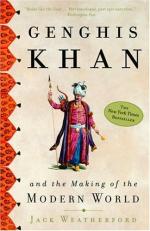|
This section contains 502 words (approx. 2 pages at 400 words per page) |

|
Genghis Khan and the Making of the Modern World Summary & Study Guide Description
Genghis Khan and the Making of the Modern World Summary & Study Guide includes comprehensive information and analysis to help you understand the book. This study guide contains the following sections:
This detailed literature summary also contains Topics for Discussion and a Free Quiz on Genghis Khan and the Making of the Modern World by Jack Weatherford.
Genghis Khan and the Making of the Modern World was written by Jack Weatherford, a professor of anthropology at Macalester College in Minnesota. His book is well-known as a work of popular history. The book tells the story of Genghis Khan's life, influence and legacy, through his successors to the present day. It focuses on a number of recently unearthed and translated historical texts that, in centuries past, were unavailable, such as the Secret History of the Mongols. Genghis Khan and the Making of the Modern World is effectively an extended attempt to rehabilitate the image of Genghis Khan in a much more positive light than is normal for Western historiography.
The work is far friendlier to the Mongols and is included in a string of books that have reconceived the personality and life of Genghis Khan. Weatherford argues that the Mongols are not the horrible, conquering hordes of Western imagination, but instead Mongols tended to be egalitarian, destroying local hierarchies. They also tended to treat the general population much better than the rulers they deposed and were widely tolerant of religious differences. They imposed fewer taxes and had less administration. The Mongols also promoted universal education.
Mongols were innovators in military tactics, to be sure, but they also fostered the use of modern propaganda, massive free trade routes, modern international rule of law and the free exchange of ideas. The Mongols tended to rule by consensus, rather than by orders, widely promoted the use of paper money, reduced the use of torture and created the idea of diplomatic immunity. While Weatherford's book is thought to contain a number of important historical errors, it has done much to revive interest in the Mongol Empire and the man who created it.
Genghis Khan and the Making of the Modern World contains and introduction and three broad parts. Part I, The Reign of Terror on the Steppe, 1162-1206, tells the story of Genghis Khan's youth, rise to power and adulthood through Chapter 1, The Blood Clot, Chapter 2, Tale of Three Rivers, and Chapter 3, War of the Khans. Part II, The Mongol World War, 1211-1261, continues Genghis Khan's expansion of the Mongol Empire, chronicles his death and discusses the fate of the empire thereafter, through Chapters 4-7, which see the Mongol Empire expand through much of China and all the way to Europe.
Part III, The Global Awakening, 1262-1962, contains the final three chapters. It begins with the rule of Genghis Khan's grandson, Khubilai Khan and his Eastern Mongol Empire. From there it explains how the Mongol Empire extended to its furthest reaches under the divided kingdoms of Genghis's grandchildren and how the Mongol Empire was eventually assimilated into the cultures they ruled due to the bubonic plague's destruction of the global economy. Chapter 10, Empire of Illusion, explains how Genghis Khan's and the Mongol's image was destroyed among Westerners during the Enlightenment. The book ends with an epilogue, which follows up the introduction's story of Weatherford's expedition to Genghis Khan's burial lands.
Read more from the Study Guide
|
This section contains 502 words (approx. 2 pages at 400 words per page) |

|



